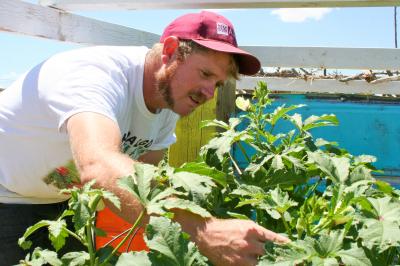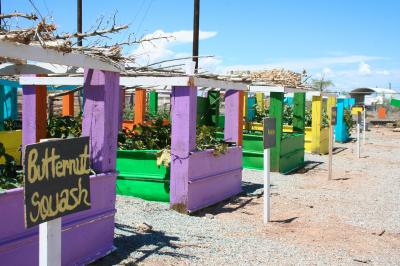Youth gardens can help address New Mexico's food desert problems


Nestled between railroad tracks and Interstate 10 in Lordsburg, N.M. is a brightly colored desert oasis. This collection of vegetable gardens is contributing to a cooperative solution for one of Hidalgo County's biggest challenges: being designated by the U.S. Department of Agriculture as a food desert.
The USDA defines food deserts as "urban neighborhoods and rural towns without ready access to fresh, healthy and affordable food." The map of food desert areas shows that much of the state of New Mexico is considered a food desert, with the exception of the areas immediately surrounding Las Cruces, Albuquerque and Santa Fe or sparsely populated areas of eastern New Mexico.
The one and only grocery store in Hidalgo County is in Lordsburg, leaving those residing in outlying communities with a commute to shop for their groceries.
New Mexico State University Extension Agriculture Agent John Allen, who has worked in the county for two years now, saw the need for more fresh produce there, and took steps to make it happen. The Hidalgo County Youth Demonstration Garden, a potential part of the food desert solution, is a series of raised bed gardens constructed by using found or upcycled materials, housed on the county fairgrounds, right next to the Extension office.
"Hidalgo County was actually identified as a food desert, which means that the access to fresh foods is very limited here," Allen said. "We have one small grocery store in the entire county. Everyone else from the outlying areas have to travel in. Our closest Walmart is about an hour away, so it can be really difficult, especially for seniors, or people who don't have the means to travel those distances to get their food."
Allen said that the importance of a demonstration garden is that people can actually visit the garden and learn about how to garden, hands-on, and ask questions in person.
"A lot of people think they can't grow anything, but they're coming out here and learning that it's not really difficult to grow a garden if you just know some of the simple steps that are required," he said.
Gardening in Hidalgo County is still somewhat difficult. The summers are very hot and dry, and the sun harsh.
"I have found it very challenging to keep a garden healthy, here in the county, especially during the summer," Allen said. "We have provided shade for most of our plants here, which has been a plus. Putting all of the gardens on a drip line with a timer means that we're able to make sure they are getting the right amount of water applied right at the base when it needed, has also helped."
The inaugural planting in the garden featured butternut squash, zucchini, okra, white scallop squash, tomatoes, sweet bell peppers, green beans, peas, pumpkins, kabocha squash (Japanese pumpkin), watermelons and Armenian cucumbers.
Before Allen could teach hands-on gardening, he had to have the garden. He partnered with Bootheel Youth Association Director Eric Moore to provide the opportunity for youth in the community to get some construction experience.
"Projects like the demonstration garden help youth develop skills while helping to better our community," Moore said. "We go out to the garden once a week and we've helped with construction of the structures and other projects."
Students from one of the middle school classes also visit the garden regularly to help.
Allen said that all of the materials used to build the beds were either already owned by the county, or found. The wooden uprights for the beds were posts that used to support guardrails on the highway; the metal siding on the beds used to be the roof on the exhibit building at the fairgrounds. The shades for the garden beds are yucca stalks from around the county.
"The wood posts were actually posts that used to hold up guardrails on the highway. We made sure we painted them and lined any part that would be touching soil with plastic, just to make sure that none of the treatment from the treated lumber touches the garden bed," Allen said. "We didn't want any of those chemicals to get into our soils."
Allen added that the yucca stalks are better at allowing rainwater to filter down into the garden beds than shade cloth is, and, they were free.
"We had a lot of plant starts we started in the hoop house in the spring and we encourage the kids to go home, and to plant some them. Going around and visiting some of these kids, we've seen a squash plant in a front yard, or a tomato," Allen said. "We had a workshop on container gardens, where we invited the community to come out to learn how to grow small plots in containers, if they don't want to go the route of the raised bed or in-ground gardens. We're trying to cover all of the bases of what they need."
The crop of new fruit and vegetable farmers in the county created another opportunity for community collaboration: a farmers' market.
"The Spirit of Hidalgo is an organization here in town that works on community development," Allen said. "We have a lot of partners - Hidalgo Medical Services, AARP, the City of Lordsburg, the county - we all came together and decided that if we're going to promote growing these gardens, and trying to increase the amount of fresh food we have available here, then we needed a market where people can take what they've grown, and help disseminate it throughout the community."
The Hidalgo Farmers' Market & Mercado started in June.
Colleen Miller, a vendor at a recent market day and 4-H mom, says that local produce is a big draw for the market, but the sense of community is, too.
"Local produce - people really like that," Miller said. "But visiting is the most fun."
On market day in August, Miller brought tomatoes, zucchini and squash from her large home garden. She also sold homemade zucchini bread, whole wheat and white breads and cinnamon rolls, while her daughter sold cookies for her 4-H project.
"We've had many vendors come out and have had a lot of food," Allen said. "We're very happy that not only are we getting people to grow the vegetables, but we're also getting people to come, make those selections and use them in their homes. And, hopefully, we're sparking a passion for growing food."


